TOYOTA RAV4 PHEV 2021 Owners Manual
Manufacturer: TOYOTA, Model Year: 2021, Model line: RAV4 PHEV, Model: TOYOTA RAV4 PHEV 2021Pages: 666, PDF Size: 161.28 MB
Page 301 of 666
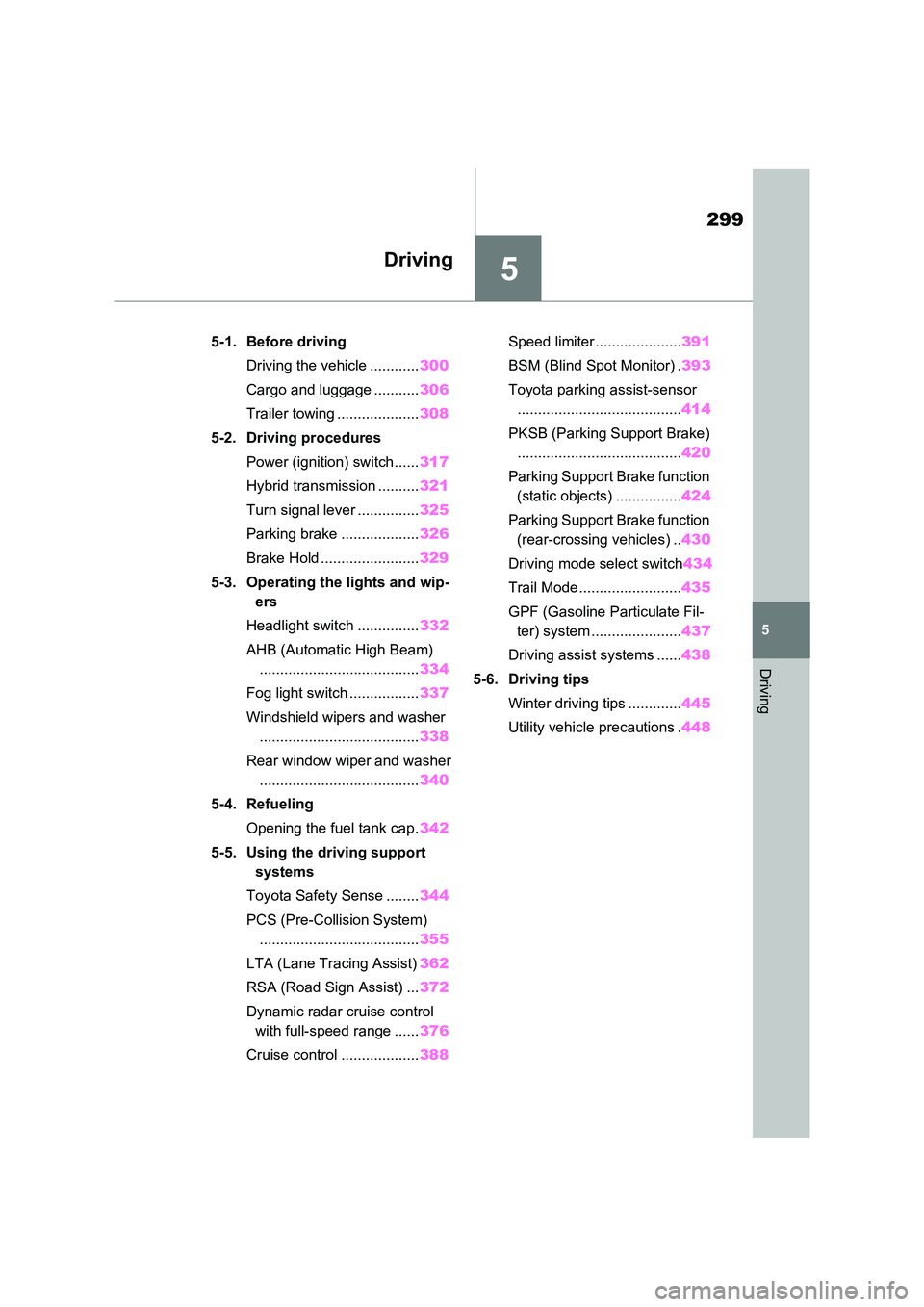
5
299
5
Driving
Driving
5-1. Before driving
Driving the vehicle ............ 300
Cargo and luggage ........... 306
Trailer towing .................... 308
5-2. Driving procedures
Power (ignition) switch ...... 317
Hybrid transmission .......... 321
Turn signal lever ............... 325
Parking brake ................... 326
Brake Hold ........................ 329
5-3. Operating the lights and wip -
ers
Headlight switch ............... 332
AHB (Automatic High Beam)
....................................... 334
Fog light switch ................. 337
Windshield wipers and washer
....................................... 338
Rear window wiper and washer
....................................... 340
5-4. Refueling
Opening the fuel tank cap. 342
5-5. Using the driving support
systems
Toyota Safety Sense ........ 344
PCS (Pre-Collision System)
....................................... 355
LTA (Lane Tracing Assist) 362
RSA (Road Sign Assist) ... 372
Dynamic radar cruise control
with full-speed range ...... 376
Cruise control ................... 388
Speed limiter ..................... 391
BSM (Blind Spot Monitor) . 393
Toyota parking assist-sensor
........................................ 414
PKSB (Parking Support Brake)
........................................ 420
Parking Support Brake function
(static objects) ................ 424
Parking Support Brake function
(rear-crossing vehicles) .. 430
Driving mode select switch 434
Trail Mode ......................... 435
GPF (Gasoline Particulate Fil -
ter) system ...................... 437
Driving assist systems ...... 438
5-6. Driving tips
Winter driving tips ............. 445
Utility vehicle precautions . 448
Page 302 of 666
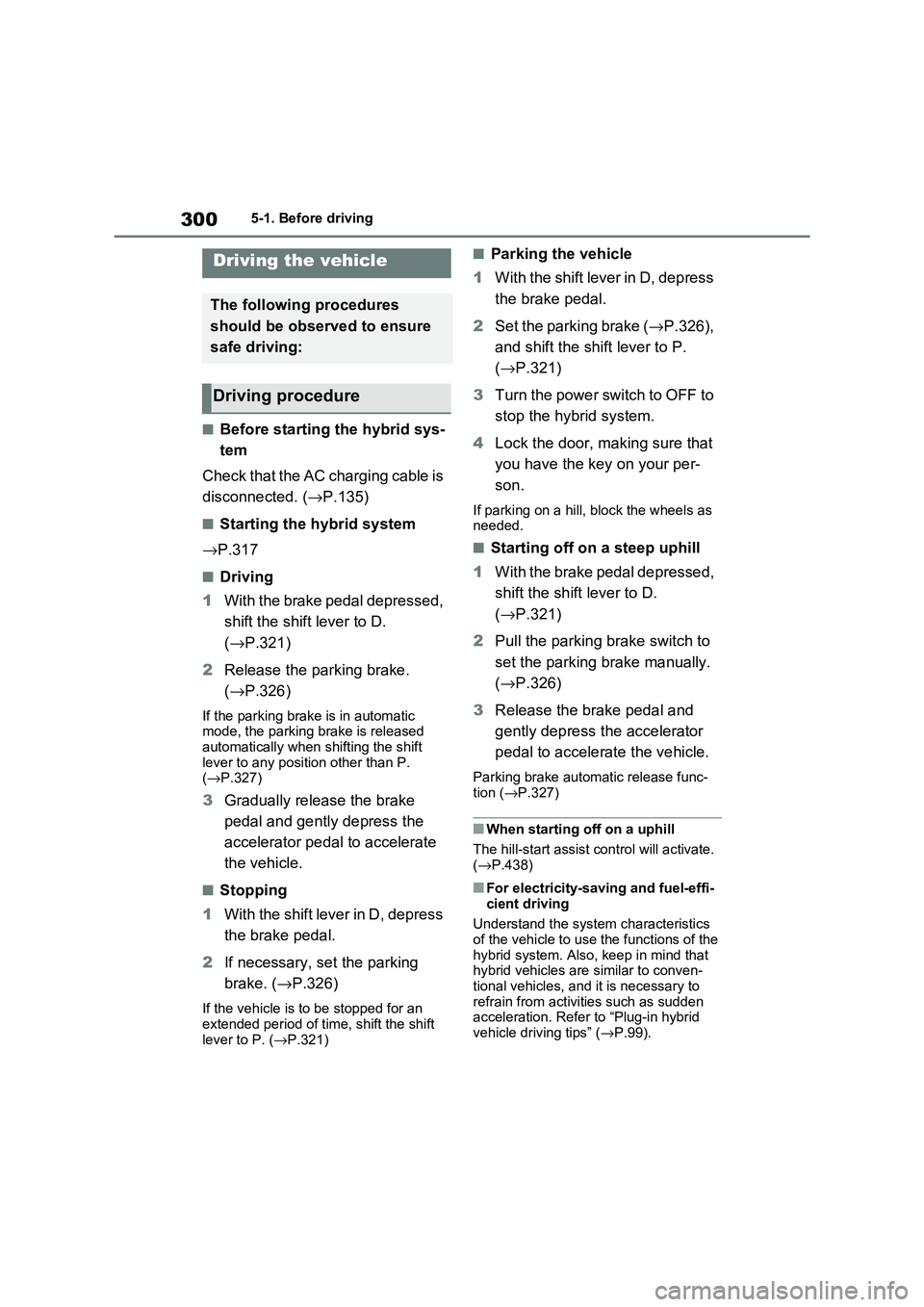
3005-1. Before driving
5-1.Before driving
■Before starting the hybrid sys-
tem
Check that the AC charging cable is
disconnected. ( →P.135)
■Starting the hybrid system
→ P.317
■Driving
1 With the brake pedal depressed,
shift the shift lever to D.
( →P.321)
2 Release the parking brake.
( →P.326)
If the parking brake is in automatic mode, the parking brake is released
automatically when shifting the shift
lever to any position other than P. ( →P.327)
3Gradually release the brake
pedal and gently depress the
accelerator pedal to accelerate
the vehicle.
■Stopping
1 W ith th e s hif t lev er in D , d ep re ss
the brake pedal.
2 If necessary, set the parking
brake. ( →P.326)
If the vehicle is to be stopped for an extended period of tim e, shift the shift
lever to P. ( →P.321)
■Parking the vehicle
1 With the shift lever in D, depress
the brake pedal.
2 Set the parking brake (→P.326),
and shift the shift lever to P.
( →P.321)
3 Turn the power switch to OFF to
stop the hybrid system.
4 Lock the door, making sure that
you have the key on your per -
son.
If parking on a hill, block the wheels as
needed.
■Starting off on a steep uphill
1 With the brake pedal depressed,
shift the shift lever to D.
( →P.321)
2 Pull the parking brake switch to
set the parking brake manually.
( →P.326)
3 Release the brake pedal and
gently depress the accelerator
pedal to accelerate the vehicle.
Parking brake automatic release func -
tion ( →P.327)
■When starting off on a uphill
The hill-start assist control will activate.
( →P.438)
■For electricity-saving and fuel-effi-
cient driving
Understand the system characteristics
of the vehicle to use the functions of the
hybrid system. Also, keep in mind that hybrid vehicles are similar to conven -
tional vehicles, and it is necessary to
refrain from activit ies such as sudden acceleration. Refer to “Plug-in hybrid
vehicle driving tips” ( →P.99).
Driving the vehicle
The following procedures
should be observed to ensure
safe driving:
Driving procedure
Page 303 of 666
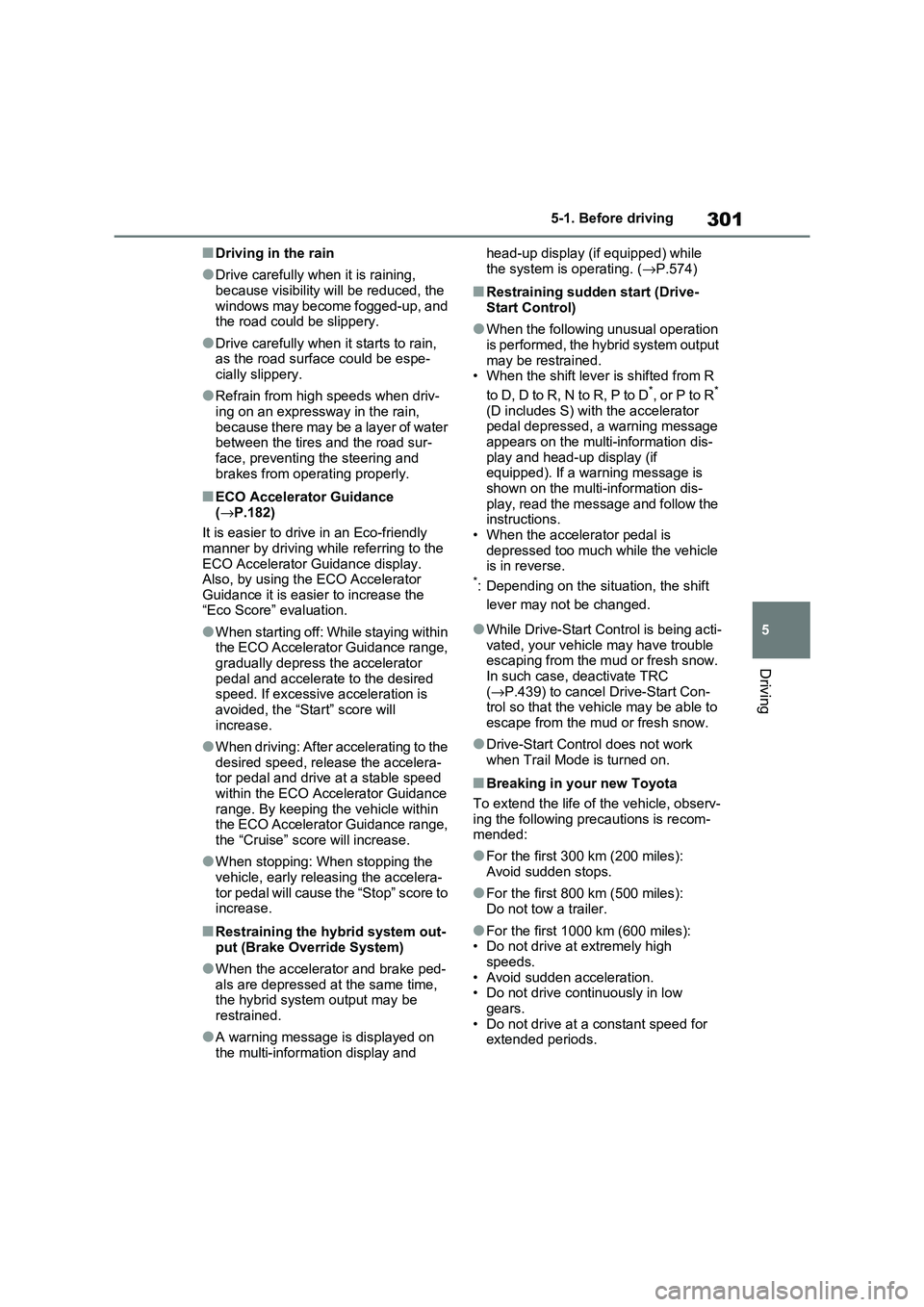
301
5
5-1. Before driving
Driving
■Driving in the rain
●Drive carefully when it is raining,
because visibility will be reduced, the
windows may become fogged-up, and the road could be slippery.
●Drive carefully when it starts to rain, as the road surfa ce could be espe-
cially slippery.
●Refrain from hig h speeds when driv-
ing on an expressw ay in the rain,
because there may be a layer of water between the tires and the road sur -
face, preventing the steering and
brakes from operating properly.
■ECO Accelerator Guidance ( →P.182)
It is easier to drive in an Eco-friendly
manner by driving while referring to the ECO Accelerator Guidance display.
Also, by using the ECO Accelerator
Guidance it is easier to increase the “Eco Score” evaluation.
●When starting off: While staying within the ECO Accelerator Guidance range,
gradually depress the accelerator
pedal and accelerate to the desired speed. If excessive acceleration is
avoided, the “Start” score will
increase.
●When driving: After accelerating to the
desired speed, release the accelera - tor pedal and drive at a stable speed
within the ECO Accelerator Guidance
range. By keeping the vehicle within the ECO Accelerator Guidance range,
the “Cruise” score will increase.
●When stopping: When stopping the
vehicle, early releasing the accelera -
tor pedal will cause the “Stop” score to increase.
■Restraining the hybrid system out - put (Brake Override System)
●When the accelerator and brake ped - als are depressed at the same time,
the hybrid system output may be
restrained.
●A warning message is displayed on
the multi-information display and
head-up display (if equipped) while
the system is operating. ( →P.574)
■Restraining sudden start (Drive- Start Control)
●When the following unusual operation is performed, the hybrid system output
may be restrained.
• When the shift leve r is shifted from R
to D, D to R, N to R, P to D*, or P to R*
(D includes S) with the accelerator
pedal depressed, a warning message appears on the multi-information dis -
play and head-up display (if
equipped). If a warning message is shown on the multi-information dis -
play, read the message and follow the
instructions. • When the accelerator pedal is
depressed too much while the vehicle
is in reverse.*: Depending on the sit uation, the shift
lever may not be changed.
●While Drive-Start Control is being acti -
vated, your vehicle may have trouble escaping from the mud or fresh snow.
In such case, deactivate TRC
( →P.439) to cancel Drive-Start Con- trol so that the vehi cle may be able to
escape from the mud or fresh snow.
●Drive-Start Control does not work
when Trail Mode is turned on.
■Breaking in your new Toyota
To extend the life of the vehicle, observ- ing the following precautions is recom -
mended:
●For the first 300 km (200 miles):
Avoid sudden stops.
●For the first 800 km (500 miles):
Do not tow a trailer.
●For the first 1000 km (600 miles): • Do not drive at extremely high
speeds.
• Avoid sudden acceleration. • Do not drive continuously in low
gears.
• Do not drive at a c onstant speed for extended periods.
Page 304 of 666
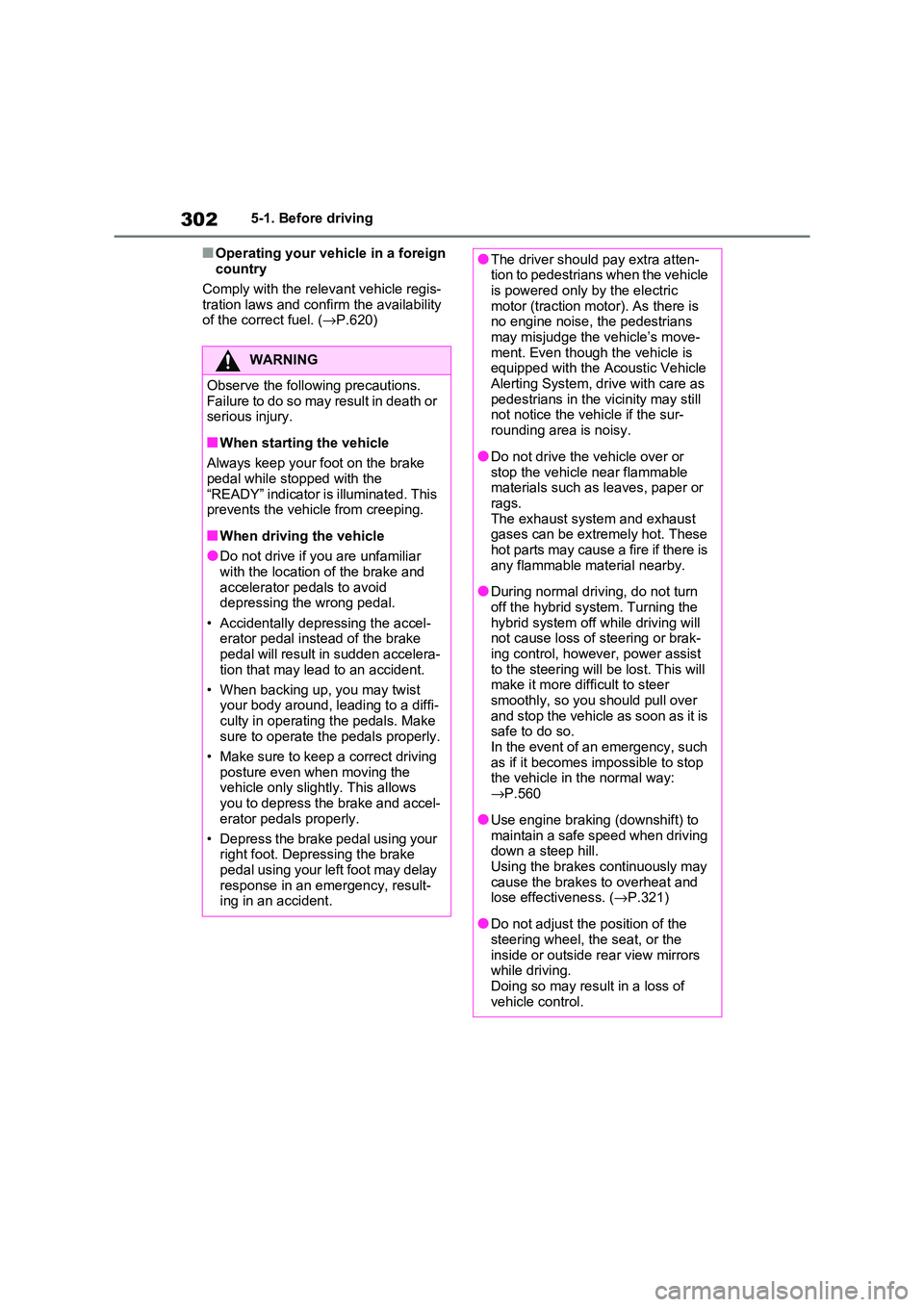
3025-1. Before driving
■Operating your vehicle in a foreign
country
Comply with the rele vant vehicle regis-
tration laws and confi rm the availability
of the correct fuel. ( →P.620)
WARNING
Observe the following precautions.
Failure to do so may result in death or
serious injury.
■When starting the vehicle
Always keep your f oot on the brake
pedal while stopped with the “READY” indicator is illuminated. This
prevents the vehicle from creeping.
■When driving the vehicle
●Do not drive if you are unfamiliar
with the location of the brake and accelerator pe dals to avoid
depressing the wrong pedal.
• Accidentally depressing the accel - erator pedal instead of the brake
pedal will result in sudden accelera -
tion that may lead to an accident.
• When backing up, you may twist
your body around, leading to a diffi -
culty in operating the pedals. Make sure to operate th e pedals properly.
• Make sure to keep a correct driving
posture even when moving the vehicle only slightly. This allows
you to depress the brake and accel -
erator pedals properly.
• Depress the brake pedal using your
right foot. Depressing the brake
pedal using your left foot may delay response in an emergency, result -
ing in an accident.
●The driver should pay extra atten - tion to pedestrians when the vehicle
is powered only b y the electric
motor (traction motor). As there is no engine noise, the pedestrians
may misjudge the vehicle’s move-
ment. Even though the vehicle is equipped with the Acoustic Vehicle
Alerting System, drive with care as
pedestrians in the vicinity may still not notice the ve hicle if the sur-
rounding area is noisy.
●Do not drive the vehicle over or
stop the vehicle near flammable
materials such as leaves, paper or rags.
The exhaust system and exhaust
gases can be extremely hot. These hot parts may cause a fire if there is
any flammable material nearby.
●During normal driving, do not turn
off the hybrid system. Turning the
hybrid system off while driving will not cause loss of steering or brak -
ing control, however, power assist
to the steering will be lost. This will make it more difficult to steer
smoothly, so you should pull over
and stop the vehicle as soon as it is safe to do so.
In the event of an emergency, such
as if it becomes impossible to stop the vehicle in the normal way:
→ P.560
●Use engine braking (downshift) to
maintain a safe speed when driving
down a steep hill. Using the brakes continuously may
cause the brakes to overheat and
lose effectiveness. ( →P.321)
●Do not adjust the position of the
steering wheel, t he seat, or the
inside or outside rear view mirrors while driving.
Doing so may result in a loss of
vehicle control.
Page 305 of 666
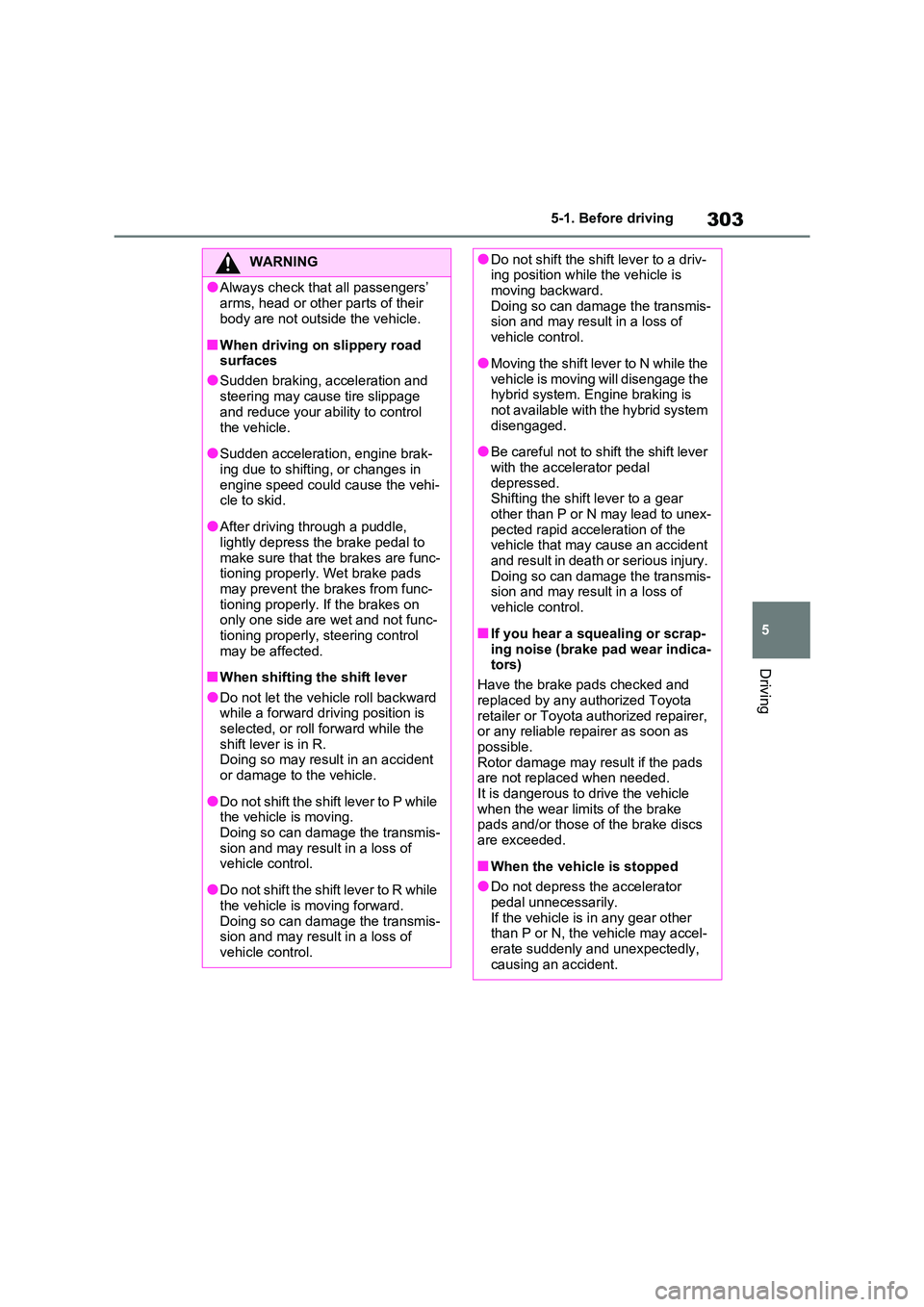
303
5
5-1. Before driving
Driving
WARNING
●Always check that all passengers’
arms, head or other parts of their
body are not outside the vehicle.
■When driving on slippery road
surfaces
●Sudden braking, acceleration and
steering may cause tire slippage
and reduce your ability to control
the vehicle.
●Sudden acceleration, engine brak -
ing due to shifting, or changes in engine speed could cause the vehi -
cle to skid.
●After driving through a puddle,
lightly depress the brake pedal to
make sure that the brakes are func - tioning properly. Wet brake pads
may prevent the brakes from func -
tioning properly. If the brakes on only one side are wet and not func-
tioning properly, steering control
may be affected.
■When shifting the shift lever
●Do not let the vehi cle roll backward while a forward driving position is
selected, or roll forward while the
shift lever is in R. Doing so may result in an accident
or damage to the vehicle.
●Do not shift the shift lever to P while
the vehicle is moving.
Doing so can damage the transmis - sion and may result in a loss of
vehicle control.
●Do not shift the shift lever to R while
the vehicle is moving forward.
Doing so can damage the transmis - sion and may result in a loss of
vehicle control.
●Do not shift the sh ift lever to a driv- ing position while the vehicle is
moving backward.
Doing so can dama ge the transmis- sion and may resu lt in a loss of
vehicle control.
●Moving the shift lever to N while the
vehicle is moving will disengage the
hybrid system. Engine braking is not available with the hybrid system
disengaged.
●Be careful not to shift the shift lever
with the accelerator pedal
depressed. Shifting the shift lever to a gear
other than P or N may lead to unex -
pected rapid acceleration of the vehicle that may cause an accident
and result in death or serious injury.
Doing so can dama ge the transmis- sion and may resu lt in a loss of
vehicle control.
■If you hear a squealing or scrap -
ing noise (brake pad wear indica -
tors)
Have the brake pads checked and
replaced by any authorized Toyota
retailer or Toyota a uthorized repairer, or any reliable repairer as soon as
possible.
Rotor damage may result if the pads are not replaced when needed.
It is dangerous to drive the vehicle
when the wear limits of the brake pads and/or those of the brake discs
are exceeded.
■When the vehicle is stopped
●Do not depress the accelerator
pedal unnecessarily.
If the vehicle is i n any gear other than P or N, the vehicle may accel -
erate suddenly an d unexpectedly,
causing an accident.
Page 306 of 666
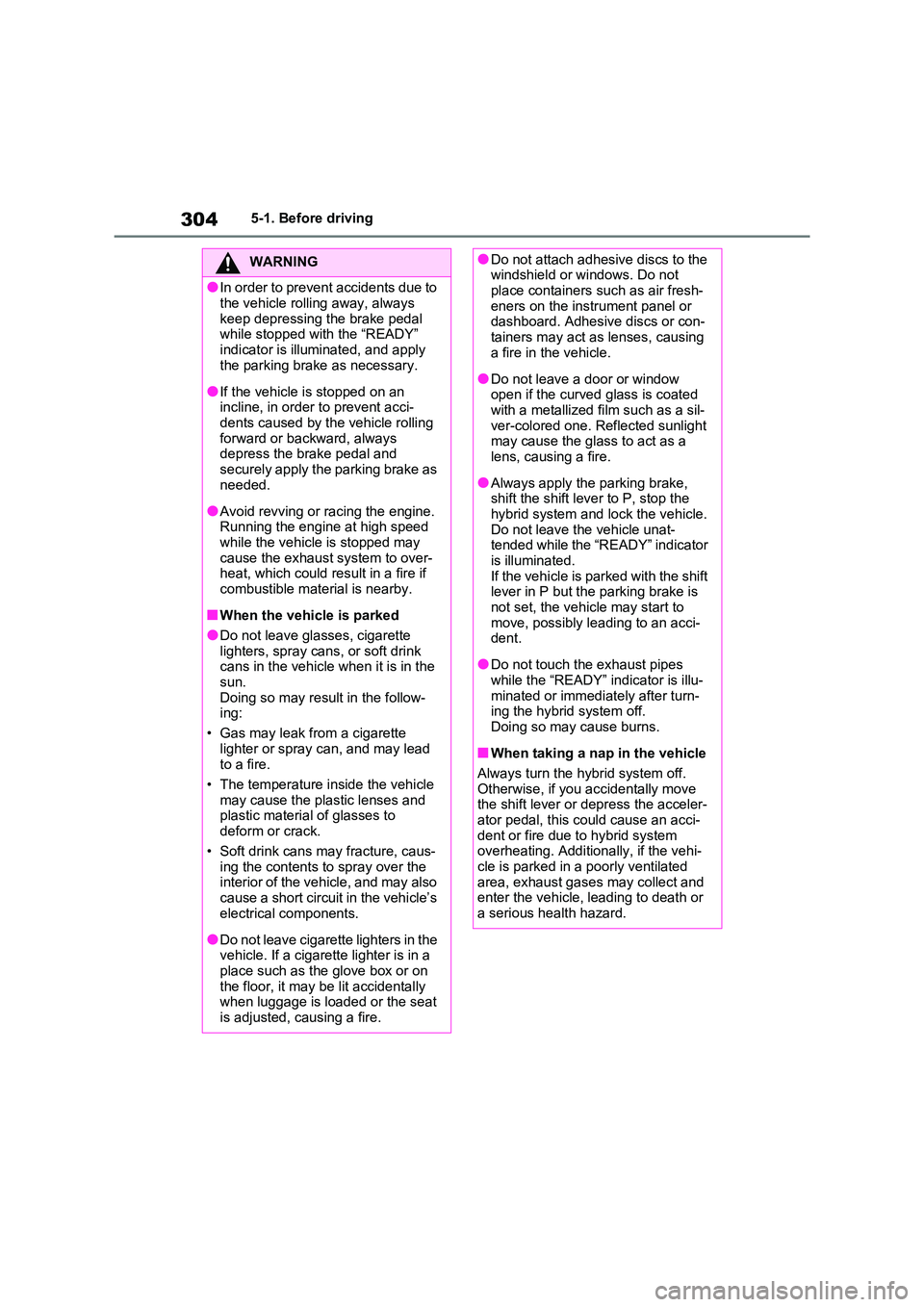
3045-1. Before driving
WARNING
●In order to prevent accidents due to
the vehicle rolling away, always
keep depressing the brake pedal while stopped with the “READY”
indicator is illuminated, and apply
the parking brake as necessary.
●If the vehicle is stopped on an
incline, in order to prevent acci -
dents caused by t he vehicle rolling forward or backward, always
depress the brake pedal and
securely apply the parking brake as needed.
●Avoid revving or racing the engine.Running the engine at high speed
while the vehicle is stopped may
cause the exhaust system to over- heat, which could result in a fire if
combustible material is nearby.
■When the vehicle is parked
●Do not leave glasses, cigarette
lighters, spray can s, or soft drink cans in the vehicle when it is in the
sun.
Doing so may result in the follow - ing:
• Gas may leak from a cigarette
lighter or spray c an, and may lead to a fire.
• The temperature inside the vehicle
may cause the plastic lenses and plastic material of glasses to
deform or crack.
• Soft drink cans may fracture, caus - ing the contents to spray over the
interior of the vehicle, and may also
cause a short circuit in the vehicle’s electrical components.
●Do not leave cigarette lighters in the vehicle. If a cigarette lighter is in a
place such as the glove box or on
the floor, it may be lit accidentally when luggage is loaded or the seat
is adjusted, causing a fire.
●Do not attach adhesive discs to the windshield or windows. Do not
place containers such as air fresh -
eners on the instrument panel or dashboard. Adhesive discs or con -
tainers may act as lenses, causing
a fire in the vehicle.
●Do not leave a door or window
open if the curved glass is coated with a metallized fi lm such as a sil-
ver-colored one. Reflected sunlight
may cause the gl ass to act as a lens, causing a fire.
●Always apply the parking brake, shift the shift lev er to P, stop the
hybrid system and lock the vehicle.
Do not leave the vehicle unat - tended while the “READY” indicator
is illuminated.
If the vehicle is parked with the shift lever in P but the parking brake is
not set, the vehicl e may start to
move, possibly leading to an acci - dent.
●Do not touch the exhaust pipes while the “READY” indicator is illu -
minated or immediately after turn -
ing the hybrid system off. Doing so may cause burns.
■When taking a nap in the vehicle
Always turn the hybrid system off.
Otherwise, if you accidentally move
the shift lever or depress the acceler - ator pedal, this could cause an acci -
dent or fire due to hybrid system
overheating. Additionally, if the vehi - cle is parked in a poorly ventilated
area, exhaust gases may collect and
enter the vehi cle, leading to death or a serious health hazard.
Page 307 of 666
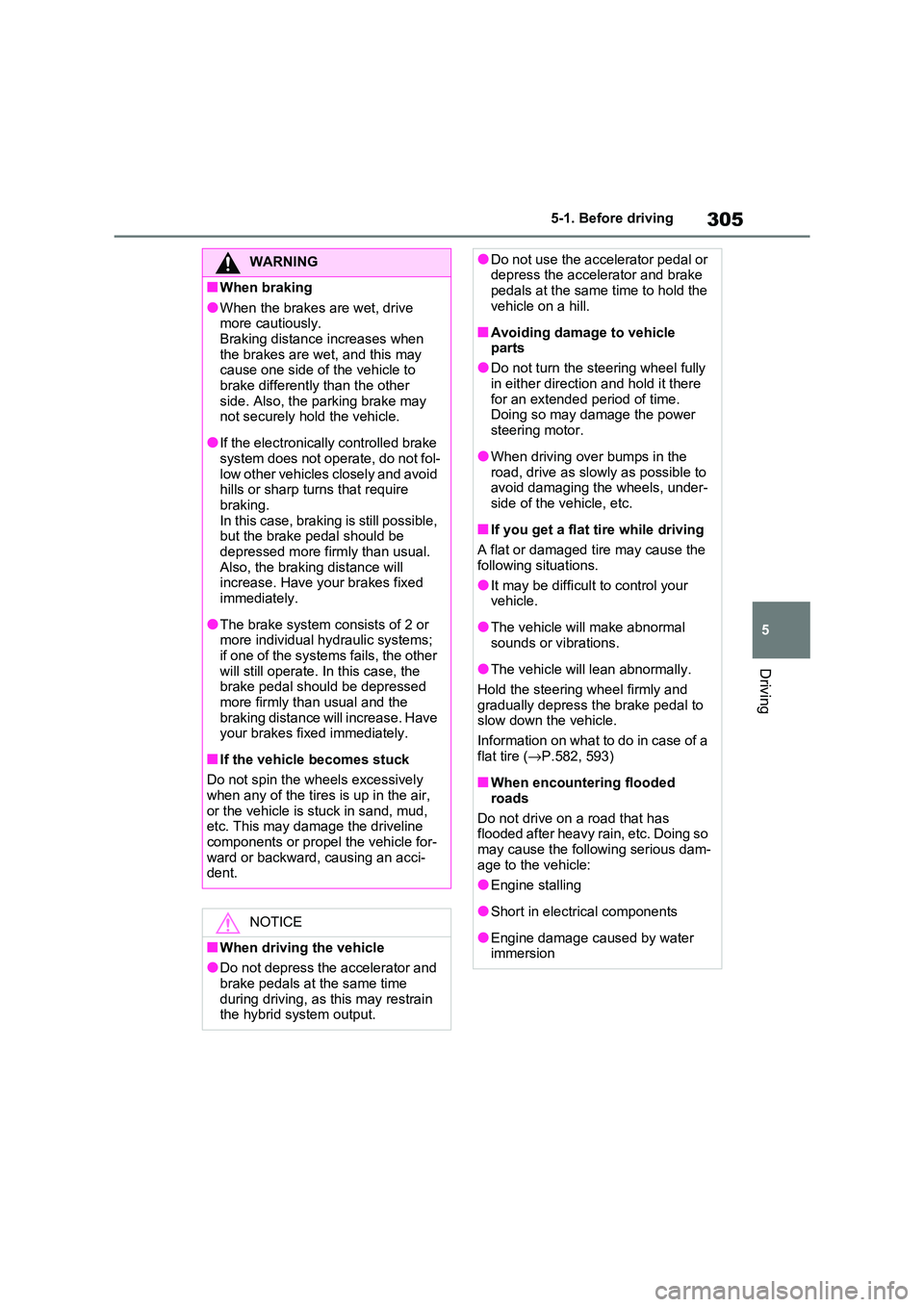
305
5
5-1. Before driving
Driving
WARNING
■When braking
●When the brakes are wet, drive
more cautiously. Braking distance increases when
the brakes are wet, and this may
cause one side of the vehicle to brake differently than the other
side. Also, the pa rking brake may
not securely hold the vehicle.
●If the electronically controlled brake
system does not operate, do not fol -
low other vehicles closely and avoid hills or sharp turns that require
braking.
In this case, braking is still possible, but the brake pedal should be
depressed more firmly than usual.
Also, the braking distance will increase. Have yo ur brakes fixed
immediately.
●The brake system c onsists of 2 or
more individual hydraulic systems;
if one of the system s fails, the other will still operate. I n this case, the
brake pedal should be depressed
more firmly than usual and the braking distance will increase. Have
your brakes fixed immediately.
■If the vehicle becomes stuck
Do not spin the wheels excessively
when any of the tires is up in the air, or the vehicle is stuck in sand, mud,
etc. This may damage the driveline
components or propel the vehicle for - ward or backward, causing an acci -
dent.
NOTICE
■When driving the vehicle
●Do not depress the accelerator and brake pedals at the same time
during driving, as t his may restrain
the hybrid system output.
●Do not use the accelerator pedal or depress the accelerator and brake
pedals at the same time to hold the
vehicle on a hill.
■Avoiding damage to vehicle
parts
●Do not turn the ste ering wheel fully
in either directio n and hold it there
for an extended period of time. Doing so may damage the power
steering motor.
●When driving over bumps in the
road, drive as slowly as possible to
avoid damaging the wheels, under - side of the vehicle, etc.
■If you get a flat tire while driving
A flat or damaged t ire may cause the
following situations.
●It may be difficult to control your vehicle.
●The vehicle will make abnormal sounds or vibrations.
●The vehicle will lean abnormally.
Hold the steering wheel firmly and
gradually depress t he brake pedal to
slow down the vehicle.
Information on what to do in case of a
flat tire ( →P.582, 593)
■When encountering flooded
roads
Do not drive on a road that has flooded after heavy rain, etc. Doing so
may cause the following serious dam -
age to the vehicle:
●Engine stalling
●Short in electrical components
●Engine damage caused by water
immersion
Page 308 of 666
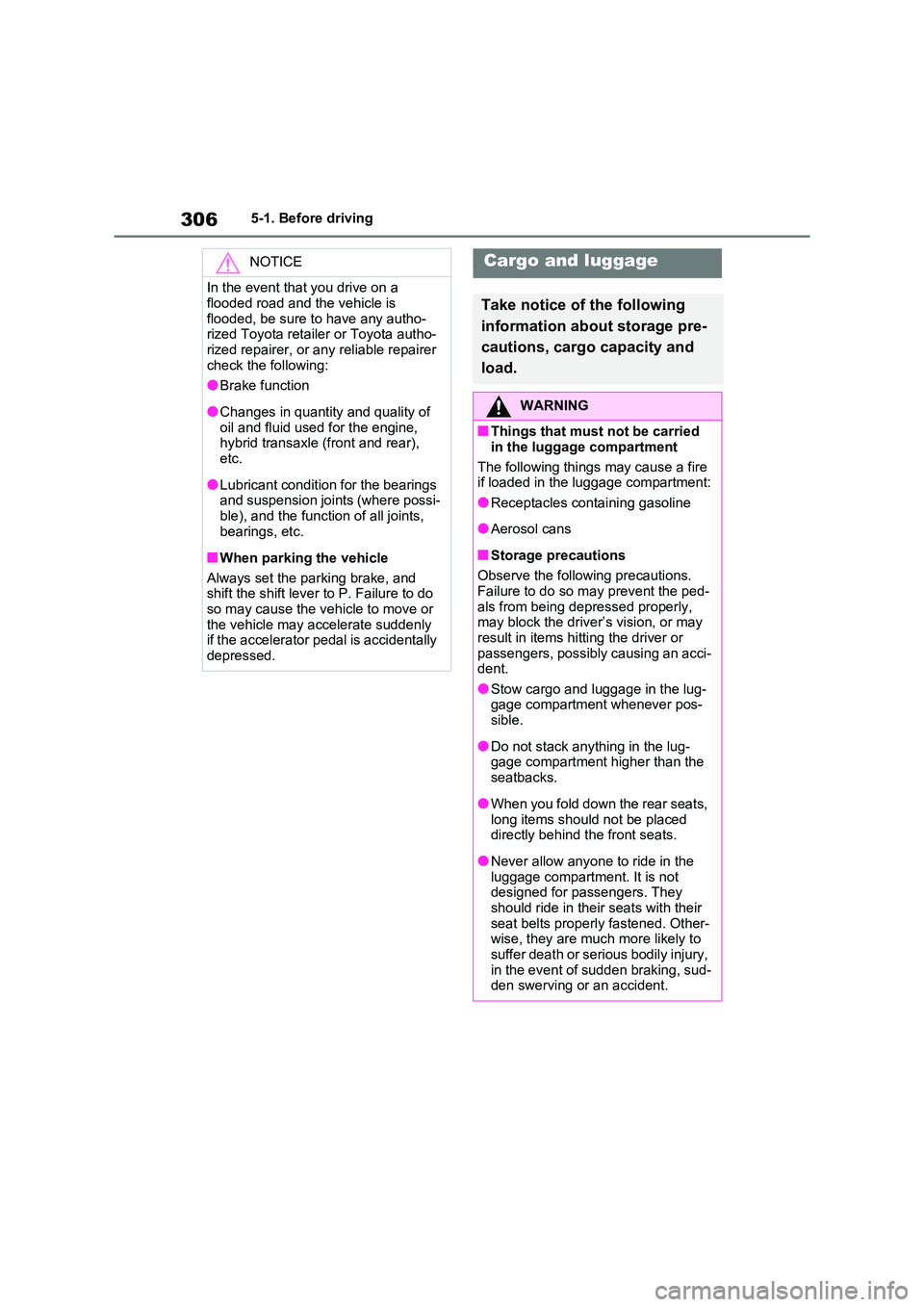
3065-1. Before driving
NOTICE
In the event that you drive on a
flooded road and the vehicle is
flooded, be sure t o have any autho- rized Toyota retailer or Toyota autho -
rized repairer, or any reliable repairer
check the following:
●Brake function
●Changes in quantity and quality of
oil and fluid used for the engine, hybrid transaxle (front and rear),
etc.
●Lubricant condition for the bearings
and suspension joints (where possi -
ble), and the function of all joints, bearings, etc.
■When parking the vehicle
Always set the park ing brake, and
shift the shift lever to P. Failure to do
so may cause the vehicle to move or the vehicle may accelerate suddenly
if the accelerator pedal is accidentally
depressed.
Cargo and luggage
Take notice of the following
information about storage pre -
cautions, cargo capacity and
load.
WARNING
■Things that must not be carried
in the luggage compartment
The following things may cause a fire if loaded in the luggage compartment:
●Receptacles containing gasoline
●Aerosol cans
■Storage precautions
Observe the following precautions.
Failure to do so m ay prevent the ped-
als from being depressed properly, may block the driver’s vision, or may
result in items hitting the driver or
passengers, possibly causing an acci - dent.
●Stow cargo and l uggage in the lug-
gage compartment whenever pos - sible.
●Do not stack anything in the lug - gage compartment higher than the
seatbacks.
●When you fold down the rear seats,
long items should not be placed
directly behind the front seats.
●Never allow anyone to ride in the
luggage compartment. It is not designed for passengers. They
should ride in their seats with their
seat belts properl y fastened. Other- wise, they are much more likely to
suffer death or serious bodily injury,
in the event of sudden braking, sud - den swerving or an accident.
Page 309 of 666
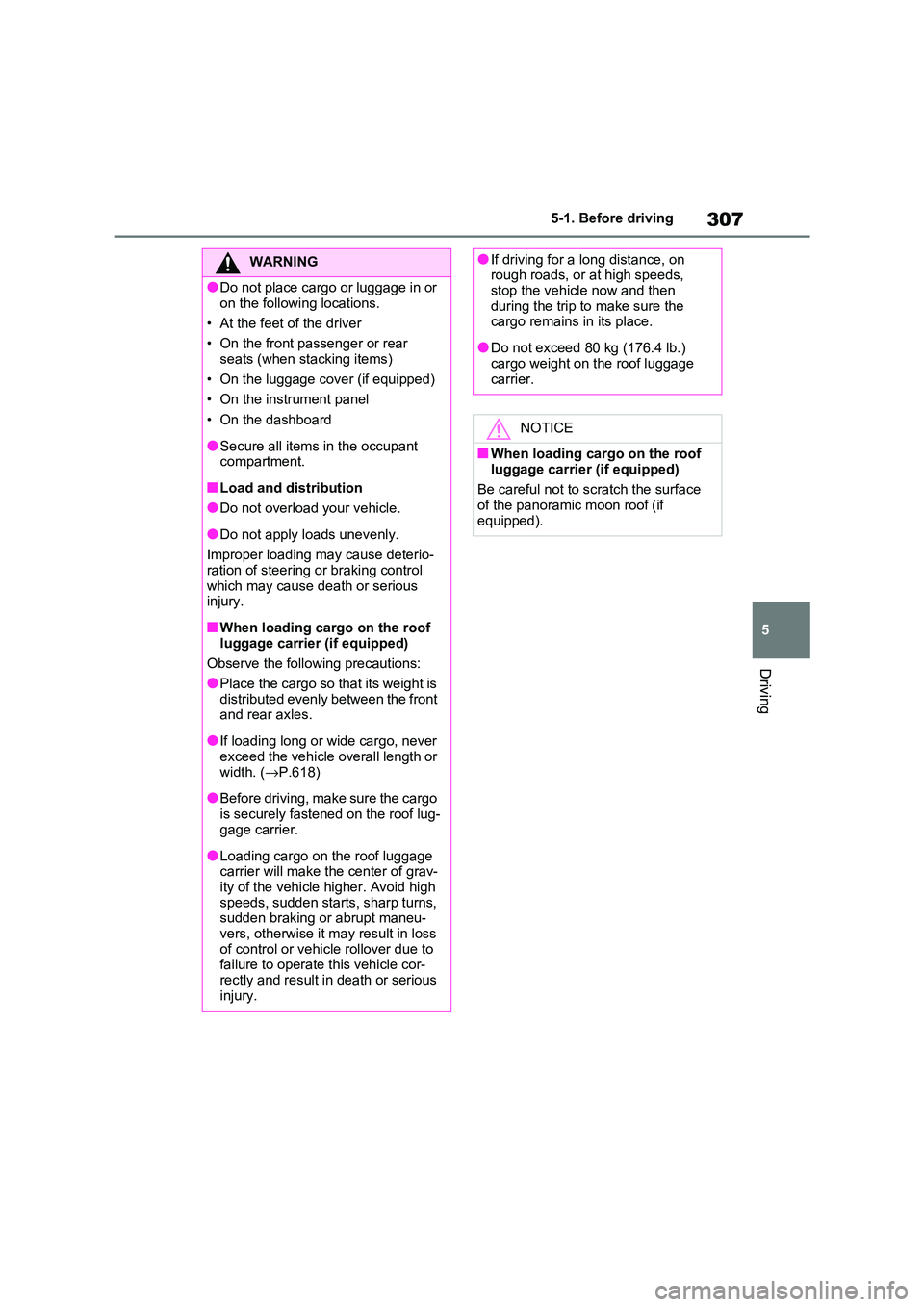
307
5
5-1. Before driving
Driving
WARNING
●Do not place cargo or luggage in or
on the following locations.
• At the feet of the driver
• On the front passenger or rear
seats (when stacking items)
• On the luggage cover (if equipped)
• On the instrument panel
• On the dashboard
●Secure all items in the occupant compartment.
■Load and distribution
●Do not overload your vehicle.
●Do not apply loads unevenly.
Improper loading may cause deterio -
ration of steering or braking control
which may cause de ath or serious injury.
■When loading cargo on the roof luggage carrier (if equipped)
Observe the following precautions:
●Place the cargo so that its weight is distributed evenly between the front
and rear axles.
●If loading long or wide cargo, never
exceed the vehicle overall length or
width. ( →P.618)
●Before driving, make sure the cargo
is securely fastened on the roof lug - gage carrier.
●Loading cargo on the roof luggage carrier will make the center of grav -
ity of the vehicle higher. Avoid high
speeds, sudden starts, sharp turns, sudden braking or abrupt maneu -
vers, otherwise it may result in loss
of control or vehicle rollover due to failure to operate this vehicle cor -
rectly and result in death or serious
injury.
●If driving for a long distance, on rough roads, or at high speeds,
stop the vehicl e now and then
during the trip to make sure the cargo remains in its place.
●Do not exceed 80 kg (176.4 lb.) cargo weight on the roof luggage
carrier.
NOTICE
■When loading cargo on the roof
luggage carrier (if equipped)
Be careful not to scratch the surface
of the panoramic moon roof (if
equipped).
Page 310 of 666
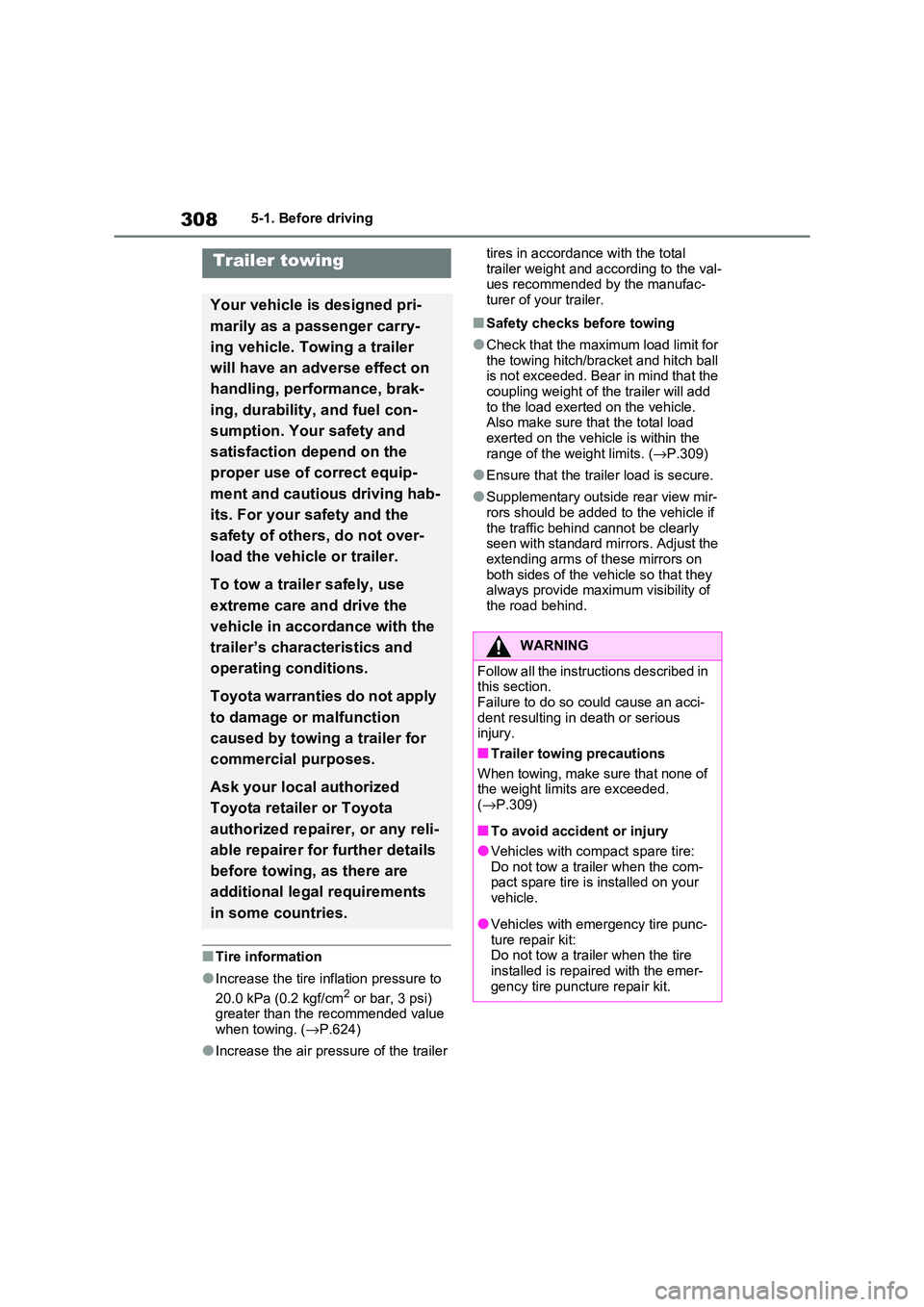
3085-1. Before driving
■Tire information
●Increase the tire inflation pressure to
20.0 kPa (0.2 kgf/cm2 or bar, 3 psi) greater than the recommended value
when towing. ( →P.624)
●Increase the air pressure of the trailer
tires in accordance with the total
trailer weight and according to the val - ues recommended by the manufac -
turer of your trailer.
■Safety checks before towing
●Check that the maximum load limit for
the towing hitch/bracket and hitch ball
is not exceeded. Bear in mind that the coupling weight of the trailer will add
to the load exerted on the vehicle.
Also make sure tha t the total load exerted on the vehi cle is within the
range of the weight limits. ( →P.309)
●Ensure that the trailer load is secure.
●Supplementary outside rear view mir- rors should be added to the vehicle if
the traffic behind c annot be clearly
seen with standard mirrors. Adjust the extending arms of these mirrors on
both sides of the vehicle so that they
always provide maxi mum visibility of the road behind.
Trailer towing
Your vehicle is designed pri -
marily as a passenger carry -
ing vehicle. Towing a trailer
will have an adverse effect on
handling, performance, brak -
ing, durability, and fuel con -
sumption. Your safety and
satisfaction depend on the
proper use of correct equip -
ment and cautious driving hab -
its. For your safety and the
safety of others, do not over -
load the vehicle or trailer.
To tow a trailer safely, use
extreme care and drive the
vehicle in accordance with the
trailer’s characteristics and
operating conditions.
Toyota warranties do not apply
to damage or malfunction
caused by towing a trailer for
commercial purposes.
Ask your local authorized
Toyota retailer or Toyota
authorized repairer, or any reli -
able repairer for further details
before towing, as there are
additional legal requirements
in some countries.
WARNING
Follow all the instructions described in
this section.
Failure to do so could cause an acci - dent resulting in death or serious
injury.
■Trailer towing precautions
When towing, make sure that none of
the weight limits are exceeded.
( →P.309)
■To avoid accident or injury
●Vehicles with compact spare tire: Do not tow a trailer when the com -
pact spare tire is installed on your
vehicle.
●Vehicles with emergency tire punc -
ture repair kit: Do not tow a traile r when the tire
installed is repa ired with the emer-
gency tire puncture repair kit.